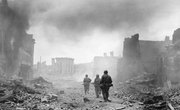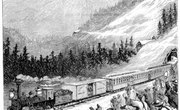With the poverty of the Great Depression and sacrifice of World War II, the 1930s and 1940s were wrought with hardship. At the close of the war, though, America entered an unprecedented time of economic prosperity that continued into the next decade. Fueled by the GI bill, increased military spending and an attitude of optimism and hope, the 1950s were an era of growing families, developing neighborhoods and a burgeoning consumerism.
From Poverty to Prosperity
With World War II military production largely ending the Depression, the U.S. entered the 1950s with the highest standard of living in the world. The G.I. Bill, which provided housing, education and monetary benefits to veterans, was a prominent factor in this economic growth, as many of the 16 million people who served in the war took advantage of the chance to build new lives and exercise their new purchasing power. Civilian spending wasn't the only contributor to the economy, however. With the dawn of the Cold War, the federal government's investments in military defense spurred further growth.
Boom Time for Babies
The growth of families also contributed to the prosperity of the 1950s. For many war veterans, a return home marked a chance to start families of their own; 3.4 million babies were born in 1946, a 20 percent increase from just a year before, according to History.com, the History Channel's website. More marriages also occurred than prior to the war, with couples choosing to have more children at younger ages. According to Scholastic.com, 75 million babies were born between 1946 and 1964. The newcomers enhanced America's economic state by giving young families a desire to provide both needs and luxuries for their children.
Welcome to the Suburbs
With money to invest in new homes and growing families, the housing market also grew in the 1950s. As a result, small neighborhood housing communities with identical homes sprang up outside American cities. According to Katherine Osburn, professor of history at Tennessee Tech University, the growth of suburban communities led to a population drop in 15 U.S. cities as more families migrated outside their borders. Living outside the city also meant a greater need for transportation. The majority of suburban families owned a car, and the development of the Interstate Highway System facilitated commutes to and from the city.
Patriotic Purchasing Power
World War II resulted in a simplistic way of living for most Americans, forcing them to forgo material desires in support of the war effort. In the 1950s, though, consumerism was no longer seen as a luxury, but as a citizen's patriotic duty in giving the country a new start. In the 1950s, TV sales skyrocketed to 5 million purchases per year, giving advertisers a wider audience for their products, according to PBS.org. Along with the advent of a five-day work week and paid vacations, this new consumerism led to a growth in the leisure industry, with McDonald's, Disneyland and hotel chains all feeding a new desire for travel.
Related Articles
References
Writer Bio
Kori Morgan holds a Bachelor of Arts in professional writing and a Master of Fine Arts in creative writing and has been crafting online and print educational materials since 2006. She taught creative writing and composition at West Virginia University and the University of Akron and her fiction, poetry and essays have appeared in numerous literary journals.











